6 Exit Intent Popup Examples and Strategies That Convince Customers to Stay
Popups come in all shapes and sizes. More often than not they’re categorised as internet trash. Whilst that might be true for some of the popups you encounter online, there is one popup variety that bucks the trend.
Exit-intent popups aren’t your standard spam. In fact, they are a marketers dream .
You’ve reached the ecommerce checkout page but decided not to purchase that pair of jeans at the last minute. Next thing you know, a little square has popped up on your screen asking if you want to save your shopping list for later, linking you to similar items, or perhaps enticing you with an exclusive and enticing offer.
Sound familiar?
If you’re running a WordPress website, you should consider using a WordPress popup plugin to capture your visitors’ attention and boost conversions.
Exit-intent popups are big business these days. Why? Because they convince customers to stick around on your website for a bit longer. The longer customers stick around, the more likely it is that their search will end in a sale.
In short, popups drive conversions. In fact, in 2020 the average popup conversion rate was 3.09%. That might seem low, but given the average conversion rate of ecommerce websites is 2.63%, it’s actually very successful!
But not all popups are made equal. In this article we’re going to arm you with six amazing exit intent popup examples and strategies that will ensure they keep fueling those conversions long into the future.
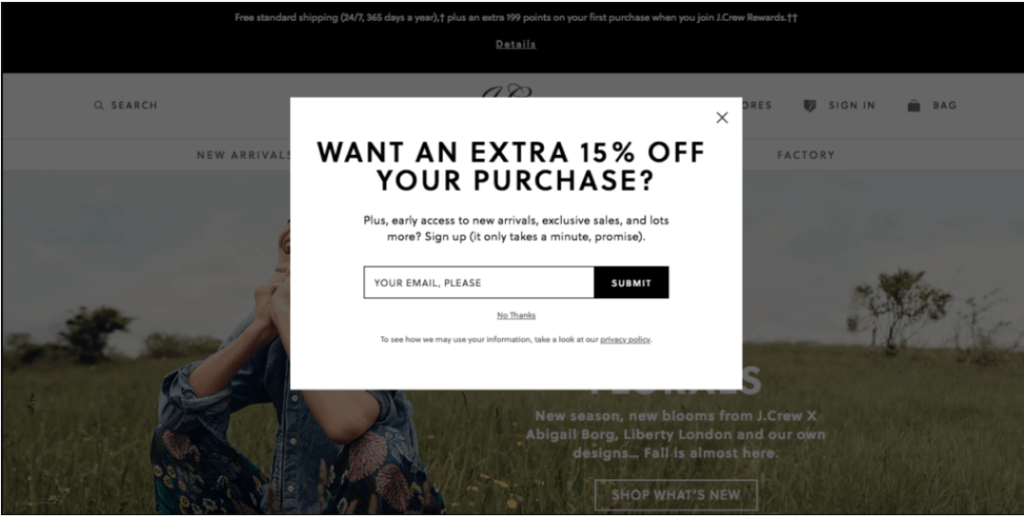
In this article
What is an exit-intent popup?
An exit-intent popup (otherwise known as an exit-popup) appears on a consumer’s phone or computer screen when they show signs that they are about to leave the website they have been browsing – in particular, if they’re abandoning their cart.
These automated popups are designed to enhance the customer journey and stop customers from leaving your website. Instead, the popup’s content is designed to encourage a purchase.
Most often this is in the form of a promotional offer, recommended items, or an enticing statistic. If somebody is teetering on the edge of a purchase decision, one of these popups might just be what it takes to sway them towards a sale.
But popups are more than just prompts. They can also be used as a way to catch useful customer information. That could be phone numbers for future outbound calls, email addresses for enhanced emailing lists, or to boost subscriptions to your brand newsletter or blog.
You could even use popups to offer an opt-in advanced shipment notification at the end of the checkout process. The possibilities are as endless as your creativity. Whatever it is you want your customer to do, a popup with the right content, in the right place, will increase your chances of getting a customer to do exactly that.
In summary, exit-popups are a simple tool that brands can use to re-engage customers who:
- Haven’t found what they’re looking for on your website
- Lost interest or became distracted whilst browsing
- Were just browsing with no clear purchase intent
A well-placed strategic popup will:
- Redirect customers to products of interest
- Re-engage customers who may have become distracted
- Promote purchase with enticing offers and contests
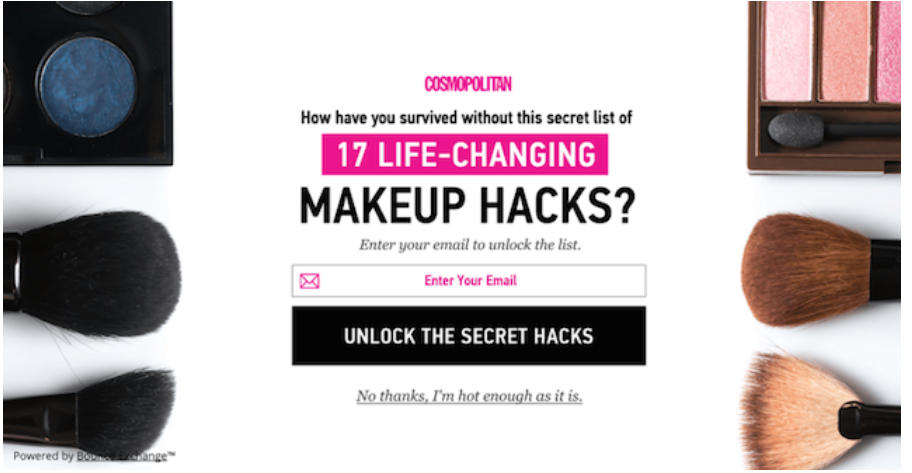
How do these popups work?
Exit-intent popups are triggered by a user’s mouse movements. Thanks to some seriously clever script, when a user shows signs that they are about to close the window and leave your website, an exit-popup can appear on their screen to keep them around for a bit longer.
That’s the mechanics behind it. But what about the psychology?
Exit-popups are designed to create an impending sense of urgency in your users. They achieve this by hitting the user with exclusive, time-limited, offers or enticing product information. That makes shoppers curious. Who doesn’t love a bargain?
Where and when to use exit popups
Placing your exit-intent popups strategically is half of the battle. By targeting the right pages, the right points in your customers’ journeys, and the right audience in general, you’ll be all set to get the most out of them. Exit-intent popups tend to perform particularly well for ecommerce sites – especially when placed on landing pages. But placement isn’t the only key to success. Everything from personalization to imagery can be used to improve and optimize your popups.
Things like:
- Including the customer’s name
- Offering content upgrades
- Adding a progress bar
- Suggesting related posts
- Using engaging words and phrases e.g. ‘wait’, ‘hang on’, ‘one last thing’ etc.
By getting this combination right, you’ll be setting yourself up for success. Did you know that the top 10% highest performing popups have an average conversions rate of 9.28%?
Why you should start using exit popups
There are dozens upon dozens of exit-intent popup examples out there – and with good reason. Unlike your everyday nuisance popups online, they’re largely unintrusive. An exit-popup doesn’t disrupt the user’s navigation. Likewise, they’re productive and authentic – there’s no security risk involved. From the marketers point of view, exit-popups are a godsend. They’re highly scalable, 100% automated and incredibly low maintenance. A win-win strategy.
Let’s take a look at some of the benefits!
Popups boost conversions
Popups boost conversions. In fact, 10 to 15% of lost visitors can be ‘saved’ by using exit-intent popups. How? Popups target cart abandonment and keep users engaged, meaning they’re more likely to buy.
Popups reduce bounce
As well as targeting cart abandonment at the checkout stage, they can be used to re-engage users before they bounce away from landing pages too. If your users aren’t finding exactly what they’re looking for within the first few seconds of visiting your site, they’re more likely to click back to Google. Exit-intent popups intervene before this can happen and use engaging information to encourage users to explore your website further.
Email list growth
By asking for email addresses in your exit-popups you’ll be able to grow your email marketing lists. Exit intent popups that ask for an email address encourage between 4 -7% of shoppers to join your mailing list.
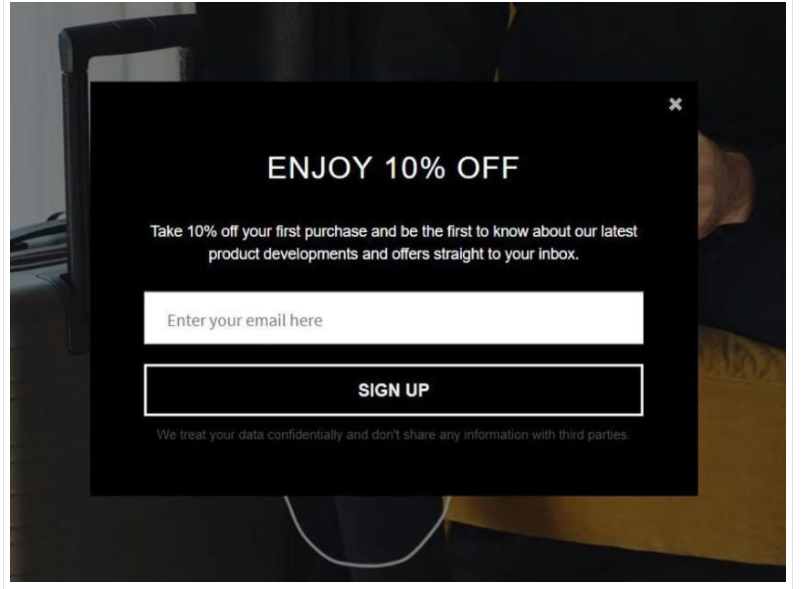
6 exit intent popup examples and strategies
So. What’s your popup objective? Reducing bounce? Increasing conversions? Whatever you’re after, there’s a popup that will fit the bill. Remember, the key ingredient here is engagement.
For those of you thinking about mobilizing an exit-intent popup strategy for your business, you’ve come to the right place. We’re going to deep-dive into six of the best popup strategies out there, from CTAs, to quizzes, and beyond.
1. A Simple Choice
Getting your customers to answer simple yes or no questions is a classic technique that really works – when we’re asked something simple, we want to respond. By targeting users with questions that relate to their browsing activity they’ll be more tempted to stay on your site, respond, and re-engage. The trick is short, punchy, relevant questions that spark interest and encourage a reaction.
Example A:
Type of popup: Cart abandonment
Popup question: Interested in one-time only coupon codes?
Customer response options: Yes or No
Example B:
Type of popup: Landing page
Popup question: Want to find out more about our one-time-only deals?
Customer response options: Yes or No
2. Call to Action
CTAs (Calls to Action) are an essential part of any marketing campaign. Using a clear, concise call to action in your exit popups will make it easier for your customers to make decisions about how to use your site. Too much choice can be overwhelming, and your clients just need a helping hand figuring out exactly what they want. An exit popup with a clever CTA is sure to capture their interest, re-engage your users and prevent bounce.
Why not try out some of these CTA keywords and phrases?
- Shop the spring collection here
- Discover how to save time and money with [your brand]
- Sign-up today
- Try out our video conferencing features
- Start your 7 day free trial
- Watch our free tutorial
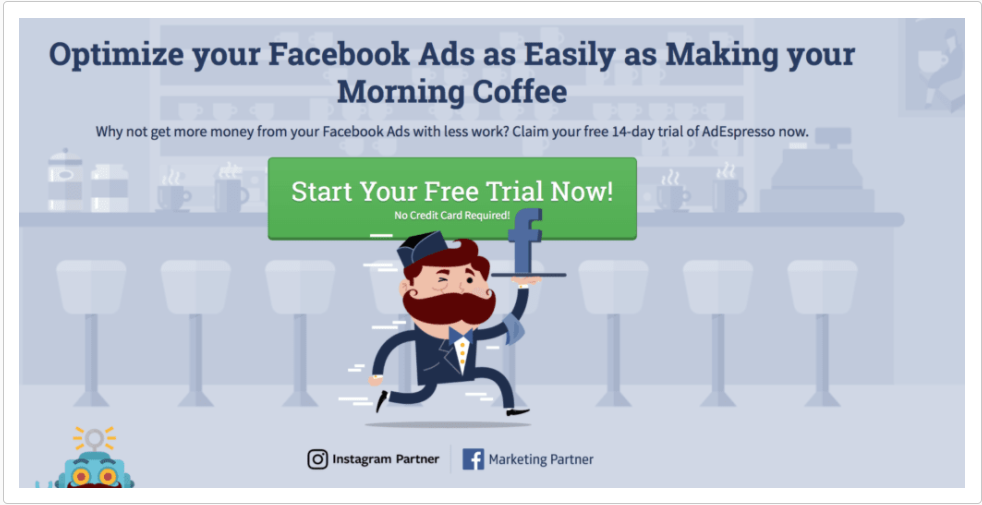
3. Collect Feedback
Collecting feedback via short surveys is essential for marketers. Exit popups can be a great way to achieve this. Simply ask your customers about their shopping experience. What do they think? Why are they clicking away? Your customers will be able to answer then and there on the popup itself – so you’ll get their real-time feedback as they shop. Remember, this shouldn’t be a full-on questionnaire. Keep questions short, sweet, and to a minimum.
Questions you could ask:
- On a scale of one to ten how would you rate your customer experience?
- Would you recommend us to friends and family?
- How satisfied are you with your shopping experience today?
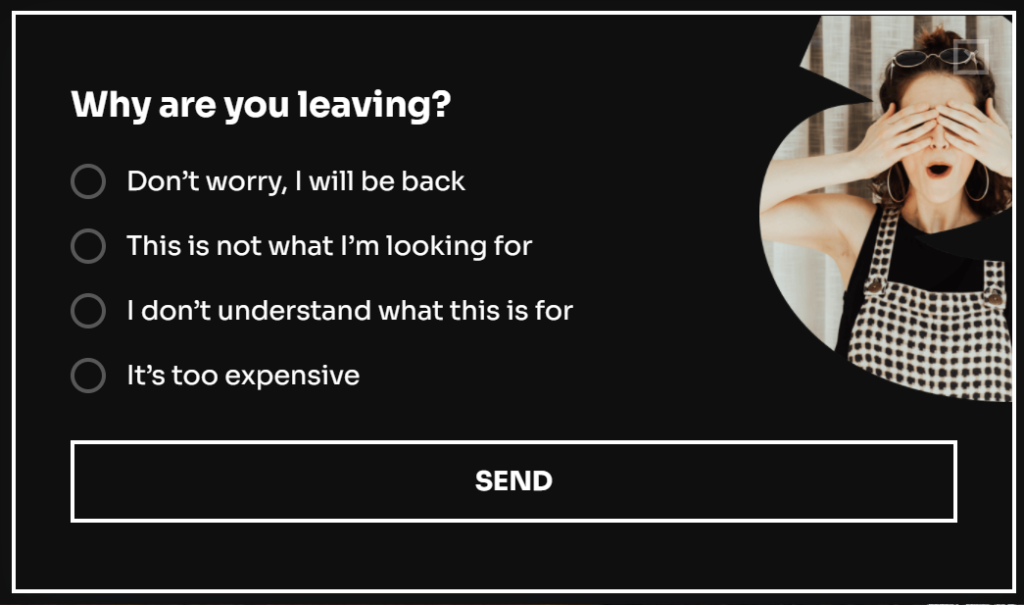
4. Offer Help
Customer relations are tricky. Not all shoppers like asking for help. When a user doesn’t find exactly what they’re looking for on your website, they won’t necessarily think to ask a customer service agent, or check out your FAQs. So offer them the help they need before they even have to ask! You’ll keep customers on your site for longer and help them find what they need (and increase the chances of a purchase).
For example, why not turn your contact form into a popup that will appear as soon as a customer reaches for the close button? Thought you couldn’t improve on your first contact resolution rate? Well, you can. You can resolve issues before they’re even voiced.
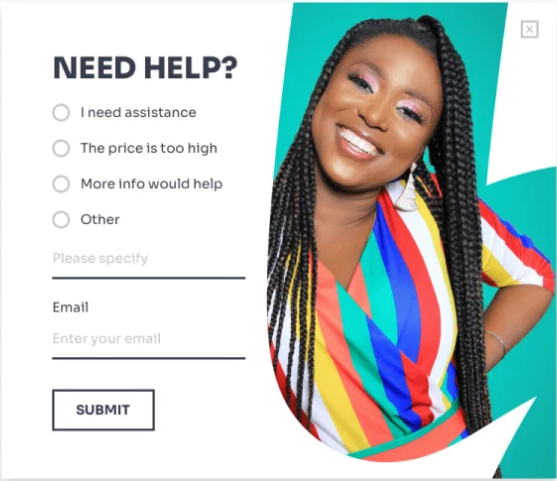
This help can even come in the form of guides, ebooks or whitepapers, especially if you’re in a technical industry. For instance, let’s say you’re selling communication software – why not offer advice about alternatives to Microsoft Teams, or statistics marketing teams need to know? This kind of broader help can encourage customers to engage with your content, leading them into returning later.
5. Make it Pretty
Of course, you’re going to want to make your exit-popups as attractive and eye-catching as possible. Visual appeal is a huge booster of engagement. Make sure your popups match your brand aesthetic and that the content is easy to read and in line with your company tone of voice. The aim is not to overwhelm your customers but to catch their attention.
Try to keep your designs minimal, with vibrant colors, and large text. Collaborative design tools make it super simple to pool ideas, so try and involve your marketers and designers to come up with a killer aesthetic that sells.
Design features to consider include:
- Background colors
- Choice of images
- Typography
- Copy layout
6. Everybody Loves a Bargain
Everyone loves a bargain. That’s a simple fact of life. Unsurprisingly, discounts and deals are one of the most popular popup options for online brands. Offering your clients discounts is a great way to encourage purchases – and help you collect that all-important customer data.
Offering some enticing savings before visitors click-away is guaranteed to catch their attention and encourage them to either stay, or come back later. For example, you could offer 20% off their next purchase over $20 or show a limited time offer that runs out in 7 days (meaning they’ll have to come back asap).
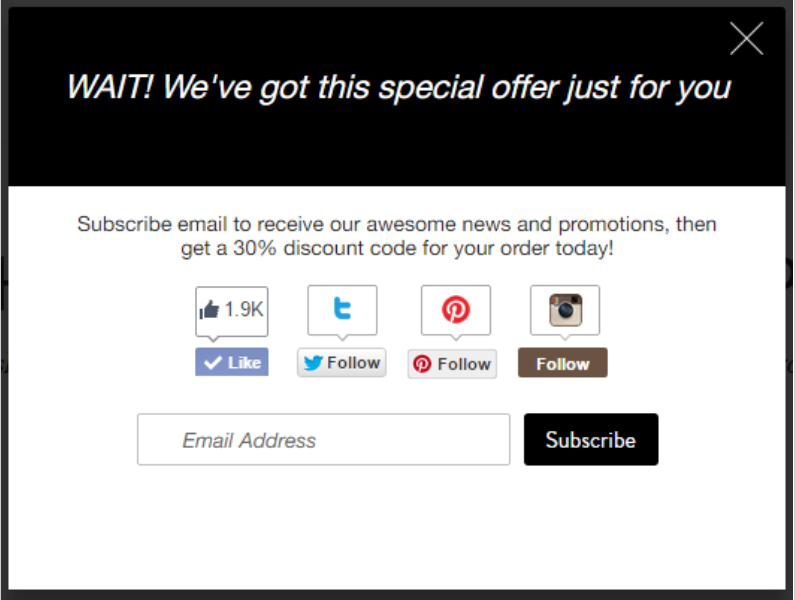
Start performing better with popups
Popups might have a bad rep. We often think of them as spam-filled internet junk to be avoided. But not all popups are made equal. Exit-intent popups are productive for customers and highly lucrative for online businesses. A well thought out exit-popup will increase conversions, reduce bounce, and equip you with the customer data you need to grow your business. An ecommerce marketing must for 2021 – and beyond.



